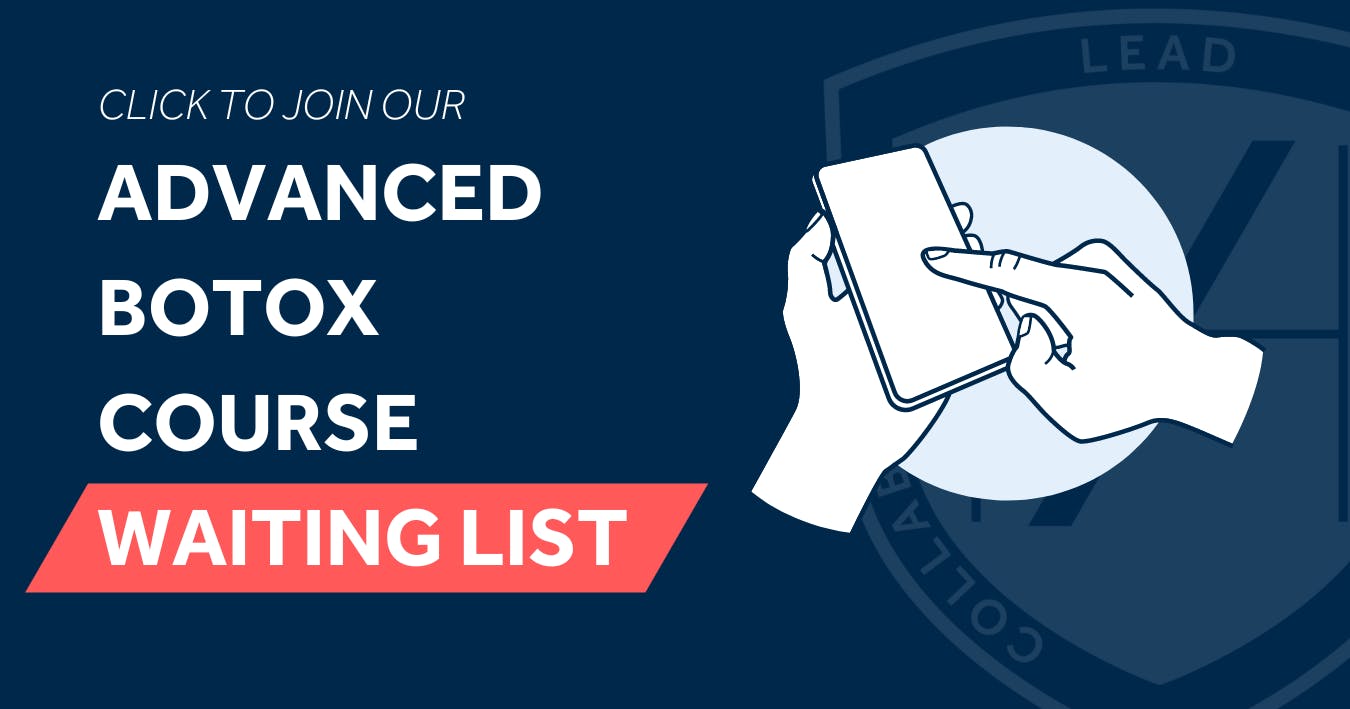Specialist Advice on How to Treat Platysmal Bands
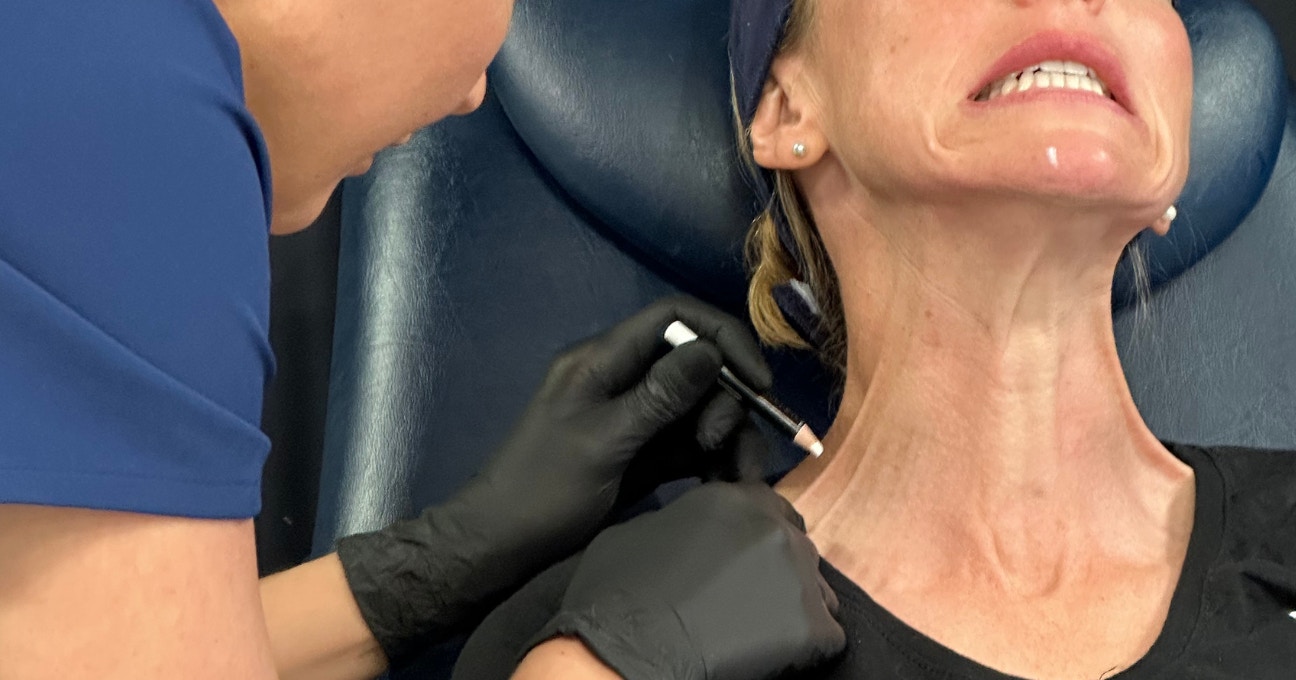
Learn how to treat platysmal bands with Dr Carol Mastropierro.
Dr Carol is a clinical trainer and aesthetics specialist at Harley Academy with dermatological and injecting experience.
Platysmal bands on the neck are one of the first signs of ageing. They’re identified by two strips of muscle running vertically down either side of the neck. These are often confused with tech neck, a colloquial term describing the premature development of horizontal lines across the neck.
Tech neck is caused by the recurrent positioning of the face downwards, a consequence of the use of technology such as mobile phones.
What are platysmal bands and how do they occur?
Dr Carol explains, “The platysma is a superficial muscle covering the neck's anterior portion. It extends from the clavicles to the mandible.
“Contraction of this muscle causes elevation of the neck and lowering of mid and lower face tissues.
“When contracted the vertical bands that make up the platysma become visible. The ageing process results in the loss of skin elasticity and the platysma muscle itself, making these lines more prominent.
“These visible bands pose no health risk but can be an aesthetic concern for some patients.”
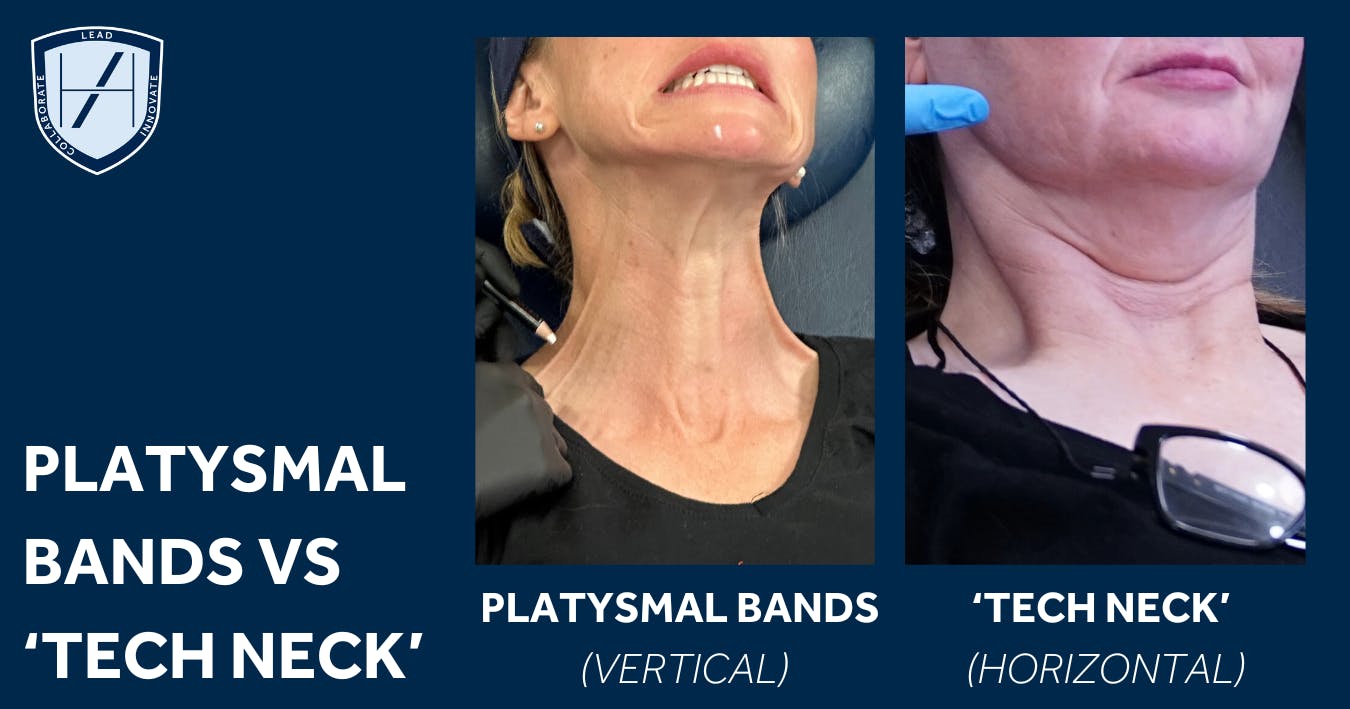
How to treat platysmal bands
We asked Dr Carol for the best treatment options for these vertical neck lines. She told us, “There are a few options for minimising the appearance of platysmal bands.
“Specific exercises to strengthen and stretch the muscle are quite popular. However, there is little evidence behind them.
“The gold standard for treating a sagging neck is a platysmaplasty - a surgical neck lift. During this surgery, the platysma muscle is repositioned and excess fat and skin are removed. Results can last up to 10 years, however, this option is the most costly and carries the most risks!”
If a patient’s looking for non-surgical options to treat their bands, Dr Carol advises the following:
“Botox and biostimulatory fillers are a good alternative for some patients. They target the muscle and the skin component of the platysma bands respectively.
“Botulinum toxin has been used in the neck for decades, often referred to as a ‘Nefertiti Lift’. The name is derived from the ancient Egyptian queen Nefertiti, who’s said to have a defined, long and graceful neck.”
Microneedling and other skin treatments, like cross linked skin boosters and polynucleotides can also be used to manage skin quality.
These treatment options can be gradually introduced and built upon. Remember, your consultations are a time to understand your patient’s aesthetic concerns and how you can treat them. It also means with each session, you can assess your patient’s treatment progress and make alterations if and when required.
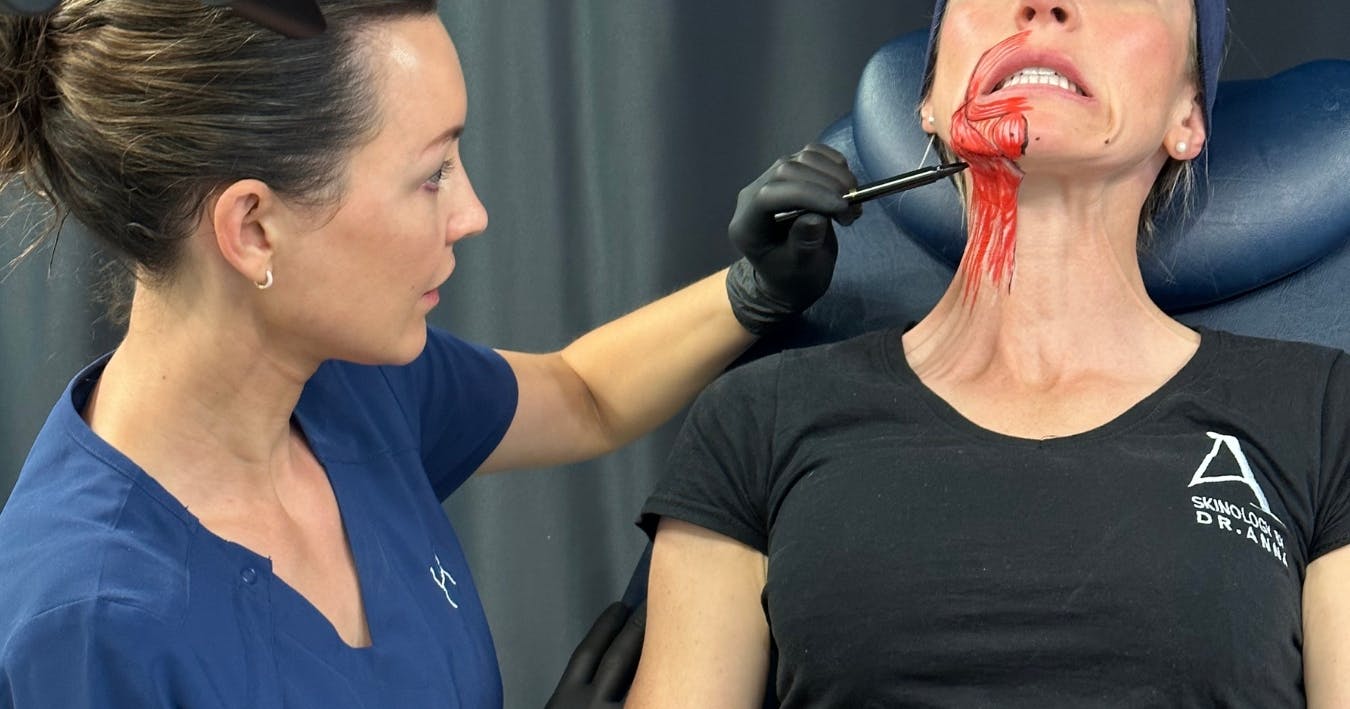
Botox injection technique for treating platysmal bands
When it comes to what techniques to use when injecting botox, start with smaller dosages. More can always be added later but you can’t take it away if you add too much!
Dr Carol shares, “You want to strategically and superficially spread several units of toxin along the bands themselves. This relieves muscle contraction and reduces the appearance of the bands themselves but even enhances jawline definition.”
Botox misconceptions
A common misconception that Dr Carol tells us practitioners frequently have is that “toxin alone can address the platysmal bands. Often patients will present with skin laxity along the band – this is where a skin treatment should be recommended alongside botox.”
Platysmal bands that are static, so present on rest, cannot be well treated with toxin alone.
Announcing our new Advanced Botox Course
Treating the platysmal bands with toxin is considered an advanced treatment. That’s one of the reasons we’re launching our new Advanced Botox Course.
This will be a digital aesthetics course for cosmetic doctors, dentists, nurses and clinical pharmacists who’ve already completed Foundation Training in botox. This could have been with us or another reputable aesthetic medicine training provider.
For further information as soon as it’s released, join the waiting list by clicking on the banner below.
Topical skincare for improved skin quality
While skincare products alone can’t treat vertical neck bands, Dr Carol notes that they can improve certain qualities.
Ideally, you want to advise patients to optimise their skin quality before having any injectable treatments. Not only can improved skin quality make your injectables results look better but it can make them appear to last longer too.
One way of doing this is through topical skincare such as retinoids and active ingredients. If you offer cosmetic dermatology services, patients can book a skin consultation separately, or as part of a holistic approach.
During our Cosmetic Dermatology Foundation Training course you’ll learn to assess the skin and devise bespoke skincare and treatment plans. This includes learning how to use skin analysis devices which help determine your patient’s treatment plans and are a fantastic, patient-friendly way to track progress.
You’ll learn about the different ingredients used to formulate skincare. This means you can decide which the best products are based on this information rather than by brand.
She comments, “Ingredients such as retinol are great for improving skin texture and increasing collagen production. Encouraging the use of peptides and sunscreen will also improve the appearance of the neck and décolletage.”
Most importantly, remind your patients not to forget the neck when applying their skincare, especially sunscreen!
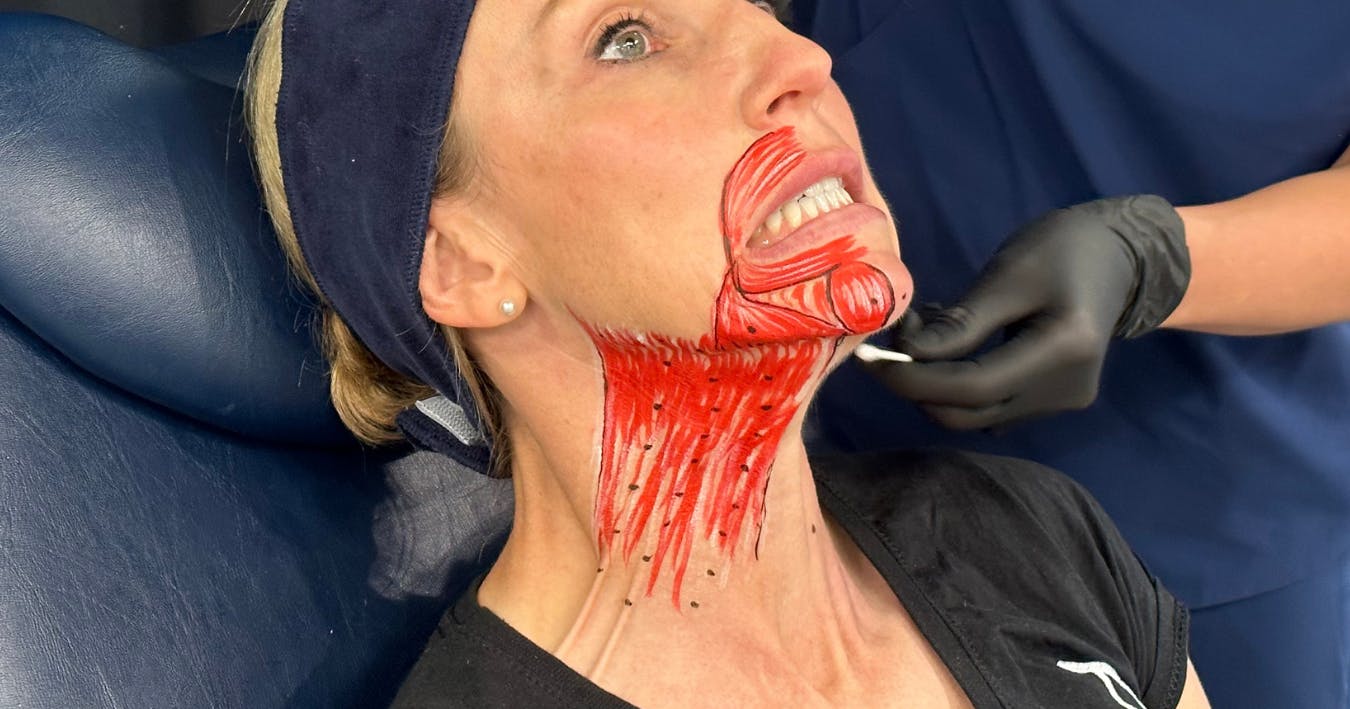
Additional platysmal band treatment options
If your patient has multiple aesthetic concerns relating to ageing and rejuvenation, you can supplement their treatment plans with the following.
Dr Carol spotlights, “Adjunct treatments include bio-remodelling through Profhilo, a great option for stimulating skin elasticity and quality.
“Other options include biostimulatory fillers, containing poly-L-lactic acid (PLLA) or calcium hydroxide (CaOH), or energy-based devices for tightening the skin, such as Morpheus 8.”
Knowledge of which skin treatment will complement which injectables can be developed with our Combined Level 7 Diploma in Botox & Dermal Fillers. This thorough aesthetics course is designed to grant you a holistic, ‘skin first’ approach to aesthetic medicine. By undertaking comprehensive training that teaches you a range of injectables and skin treatments, you’ll achieve a broad skill set. However, our Cosmetic Dermatology Course is also available separately, outside of the Combined Level 7 where it’s paired with our flagship Level 7 Diploma course.
Additionally, we offer a Profhilo Training Course which covers the face, neck and body all in one day. For trainees on our Combined Level 7 and Cosmetic Dermatology courses, this is a bonus for you!
How long do toxin results for platysmal bands last?
Dr Carol states, “Results from toxin treatment will last an average of three months.” However, this depends on a few different factors, including:
- If it’s the patient’s first treatment or they’ve had others before
- How regularly do they have platysmal bands botox
- How quickly their body metabolises it
- Lifestyle factors such as smoking and vaping.
Botox review appointments
Review appointments allow you to assess how the toxin has settled and correct any areas of asymmetry. These should be set at 2- 4 weeks after treatment. This is because the botox doesn’t reach its full capability till 2 weeks.
It’s also important not to offer tops until the two-week mark as you need to allow an appropriate amount of time for the product to take effect.
We advise injectors to consider the wording and policies around their review appointments.
Patients should be made aware that a review appointment does not equate to an automatic botox ‘top-up’. Any additional toxin injected is done so at the practitioner’s discretion and professional expertise. It’s a good idea to alert them to this before the appointment so they can manage their expectations.
What common mistakes do you see new injectors making with this treatment?
When starting anything new, mistakes are a normal and natural characteristic of growth - especially in aesthetic medicine. We encourage approaching your mistakes with kindness and using them as opportunities to reflect and learn from.
We sat down with Dr Carol to find out which common mistakes she typically sees and has experienced in her practice.
Injecting too much toxin
She told us, “Common technique mistakes include not using enough units or overdosing. Since this is an off-licence treatment with botulinum toxin, there’s no recommendation from the manufacturer regarding dosage.
“Factors such as muscle bulk, size and strength can also influence the dosage. I tend to use between 30-60 units of toxin in 2-unit, or occasionally 4-unit, aliquots and review at 3 weeks.
“Residual pull from the band can very easily be corrected, whereas unfortunately overdosing can’t.
“Occasionally signs of having administered too much toxin can result in the patient reporting difficulty swallowing. This is a temporary side effect and tends to resolve in a couple of weeks.”
Dr Carol’s top botox tip for treating vertical neck lines effectively
“A little tip I have for new injectors is to place a couple of botox units along the jawline, as well as the bands. Since the muscle attaches to the mandible, strategic placement along the jaw will enhance definition.”
Botox courses for medical professionals
If more foundational botox training is what you’re looking for, our Level 7 Diploma in Botox & Dermal Fillers course is JCCP-approved and Ofqual-regulated. This means you're getting the gold standard in aesthetics training that can take you from total beginner to specialist status.
It’s taught by our faculty of dedicated clinical trainers and we guarantee your own patients to treat. To ensure you get the time to focus on your techniques and injecting, we source all your patients for you.
Our Level 7 Diploma courses are open to doctors, dentists, nurses, clinical pharmacists and dental therapists. To find out more about our courses, book a 15-minute consultation with one of our Course Advisors. They’ll be happy to answer your questions and counsel you on what steps to take to achieve your goals.
All information correct at the time of publication
Download our full prospectus
Browse all our injectables, dermal fillers and cosmetic dermatology courses in one document
By submitting this form, you agree to receive marketing about our products, events, promotions and exclusive content. Consent is not a condition of purchase, and no purchase is necessary. Message frequency varies. View our Privacy Policy and Terms & Conditions
Attend our FREE open evening
If you're not sure which course is right for you, let us help
Join us online or in-person at our free open evening to learn more
Our Partners












STAY INFORMED
Sign up to receive industry news, careers advice, special offers and information on Harley Academy courses and services


